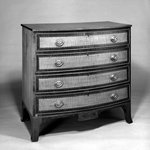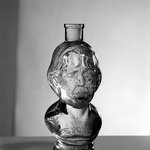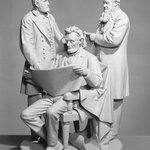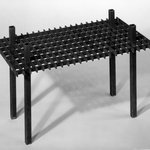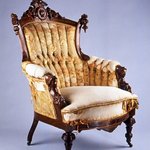
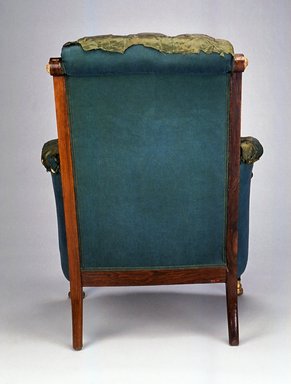
Pottier & Stymus Manufacturing Company (United States, New York, active ca. 1859–1910). Armchair (Egyptian Revival style), ca. 1870. Rosewood, burl walnut, gilt and patinated metal mounts, original upholstery, 38 1/4 x 30 x 29 in. (97.2 x 76.2 x 73.7 cm). Brooklyn Museum, Bequest of Marie Bernice Bitzer, by exchange and anonymous gift, 1992.89. Creative Commons-BY (Photo: Brooklyn Museum, CUR.1992.89_back_after_conservation.jpg)
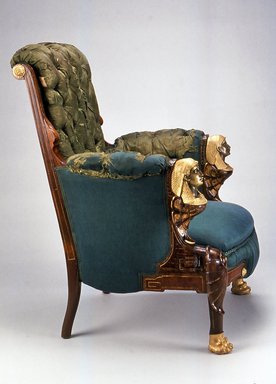
Pottier & Stymus Manufacturing Company (United States, New York, active ca. 1859–1910). Armchair (Egyptian Revival style), ca. 1870. Rosewood, burl walnut, gilt and patinated metal mounts, original upholstery, 38 1/4 x 30 x 29 in. (97.2 x 76.2 x 73.7 cm). Brooklyn Museum, Bequest of Marie Bernice Bitzer, by exchange and anonymous gift, 1992.89. Creative Commons-BY (Photo: Brooklyn Museum, CUR.1992.89_side_after_conservation.jpg)

Pottier & Stymus Manufacturing Company (United States, New York, active ca. 1859–1910). Armchair (Egyptian Revival style), ca. 1870. Rosewood, burl walnut, gilt and patinated metal mounts, original upholstery, 38 1/4 x 30 x 29 in. (97.2 x 76.2 x 73.7 cm). Brooklyn Museum, Bequest of Marie Bernice Bitzer, by exchange and anonymous gift, 1992.89. Creative Commons-BY (Photo: Brooklyn Museum, CUR.1992.89_side.jpg)

Pottier & Stymus Manufacturing Company (United States, New York, active ca. 1859–1910). Armchair (Egyptian Revival style), ca. 1870. Rosewood, burl walnut, gilt and patinated metal mounts, original upholstery, 38 1/4 x 30 x 29 in. (97.2 x 76.2 x 73.7 cm). Brooklyn Museum, Bequest of Marie Bernice Bitzer, by exchange and anonymous gift, 1992.89. Creative Commons-BY (Photo: Brooklyn Museum, CUR.1992.89_back.jpg)

Pottier & Stymus Manufacturing Company (United States, New York, active ca. 1859–1910). Armchair (Egyptian Revival style), ca. 1870. Rosewood, burl walnut, gilt and patinated metal mounts, original upholstery, 38 1/4 x 30 x 29 in. (97.2 x 76.2 x 73.7 cm). Brooklyn Museum, Bequest of Marie Bernice Bitzer, by exchange and anonymous gift, 1992.89. Creative Commons-BY (Photo: Brooklyn Museum, 1992.89_IMLS_SL2.jpg)

Pottier & Stymus Manufacturing Company (United States, New York, active ca. 1859–1910). Armchair (Egyptian Revival style), ca. 1870. Rosewood, burl walnut, gilt and patinated metal mounts, original upholstery, 38 1/4 x 30 x 29 in. (97.2 x 76.2 x 73.7 cm). Brooklyn Museum, Bequest of Marie Bernice Bitzer, by exchange and anonymous gift, 1992.89. Creative Commons-BY (Photo: Brooklyn Museum, 1992.89_right2_bw_IMLS.jpg)
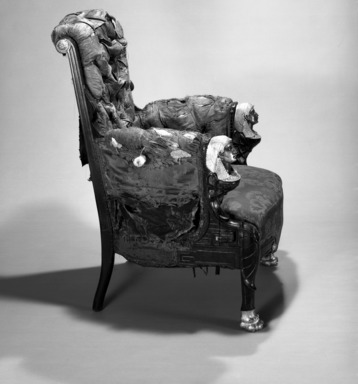
Pottier & Stymus Manufacturing Company (United States, New York, active ca. 1859–1910). Armchair (Egyptian Revival style), ca. 1870. Rosewood, burl walnut, gilt and patinated metal mounts, original upholstery, 38 1/4 x 30 x 29 in. (97.2 x 76.2 x 73.7 cm). Brooklyn Museum, Bequest of Marie Bernice Bitzer, by exchange and anonymous gift, 1992.89. Creative Commons-BY (Photo: Brooklyn Museum, 1992.89_right1_bw_IMLS.jpg)

Pottier & Stymus Manufacturing Company (United States, New York, active ca. 1859–1910). Armchair (Egyptian Revival style), ca. 1870. Rosewood, burl walnut, gilt and patinated metal mounts, original upholstery, 38 1/4 x 30 x 29 in. (97.2 x 76.2 x 73.7 cm). Brooklyn Museum, Bequest of Marie Bernice Bitzer, by exchange and anonymous gift, 1992.89. Creative Commons-BY (Photo: Brooklyn Museum, 1992.89_before_treatment_IMLS_SL2.jpg)

Pottier & Stymus Manufacturing Company (United States, New York, active ca. 1859–1910). Armchair (Egyptian Revival style), ca. 1870. Rosewood, burl walnut, gilt and patinated metal mounts, original upholstery, 38 1/4 x 30 x 29 in. (97.2 x 76.2 x 73.7 cm). Brooklyn Museum, Bequest of Marie Bernice Bitzer, by exchange and anonymous gift, 1992.89. Creative Commons-BY (Photo: Brooklyn Museum, 1992.89_back2_bw_IMLS.jpg)

Pottier & Stymus Manufacturing Company (United States, New York, active ca. 1859–1910). Armchair (Egyptian Revival style), ca. 1870. Rosewood, burl walnut, gilt and patinated metal mounts, original upholstery, 38 1/4 x 30 x 29 in. (97.2 x 76.2 x 73.7 cm). Brooklyn Museum, Bequest of Marie Bernice Bitzer, by exchange and anonymous gift, 1992.89. Creative Commons-BY (Photo: Brooklyn Museum, 1992.89_threequarter1_bw_IMLS.jpg)

Pottier & Stymus Manufacturing Company (United States, New York, active ca. 1859–1910). Armchair (Egyptian Revival style), ca. 1870. Rosewood, burl walnut, gilt and patinated metal mounts, original upholstery, 38 1/4 x 30 x 29 in. (97.2 x 76.2 x 73.7 cm). Brooklyn Museum, Bequest of Marie Bernice Bitzer, by exchange and anonymous gift, 1992.89. Creative Commons-BY (Photo: Brooklyn Museum, 1992.89_threequarter3_bw_IMLS.jpg)

Pottier & Stymus Manufacturing Company (United States, New York, active ca. 1859–1910). Armchair (Egyptian Revival style), ca. 1870. Rosewood, burl walnut, gilt and patinated metal mounts, original upholstery, 38 1/4 x 30 x 29 in. (97.2 x 76.2 x 73.7 cm). Brooklyn Museum, Bequest of Marie Bernice Bitzer, by exchange and anonymous gift, 1992.89. Creative Commons-BY (Photo: Brooklyn Museum, 1992.89_back1_bw_IMLS.jpg)

Pottier & Stymus Manufacturing Company (United States, New York, active ca. 1859–1910). Armchair (Egyptian Revival style), ca. 1870. Rosewood, burl walnut, gilt and patinated metal mounts, original upholstery, 38 1/4 x 30 x 29 in. (97.2 x 76.2 x 73.7 cm). Brooklyn Museum, Bequest of Marie Bernice Bitzer, by exchange and anonymous gift, 1992.89. Creative Commons-BY (Photo: Brooklyn Museum, 1992.89_threequarter2_bw_IMLS.jpg)

Pottier & Stymus Manufacturing Company (United States, New York, active ca. 1859–1910). Armchair (Egyptian Revival style), ca. 1870. Rosewood, burl walnut, gilt and patinated metal mounts, original upholstery, 38 1/4 x 30 x 29 in. (97.2 x 76.2 x 73.7 cm). Brooklyn Museum, Bequest of Marie Bernice Bitzer, by exchange and anonymous gift, 1992.89. Creative Commons-BY (Photo: Brooklyn Museum, 1992.89_bw.jpg)
Armchair (Egyptian Revival style)
Decorative Arts and Design
On View: Luce Visible Storage and Study Center, 5th Floor
The form of this easy chair, or bergère in French, was introduced in France in about 1725 and has remained popular. To preserve the chair as a rare original upholstery document, later layers of upholstery and padding (see illustration) were removed to uncover the original upholstery on the back and arms. The original green silk damask upholstery was cleaned in place. A modern, unfigured, green silk was used to cover the seat and front of the chair, and was set behind the original damask to compensate for losses on the back and arms. All the trim on the chair is modern, but it approximates what was originally used.





